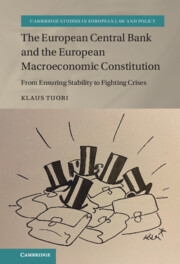 The European Central Bank and the European Macroeconomic Constitution
The European Central Bank and the European Macroeconomic Constitution from Part II - Crises, ECB Measures and the Macroeconomic Constitution
Published online by Cambridge University Press: 15 September 2022
The pandemic was a new and unforeseen event for the ECB and for the European Macroeconomic Constitution. The ECB took measures on multiple fronts to support Member States in their health, social and also public finances crises. The main approach was to support households and companies through the pandemic, so that the recovery would be as steep as the decline. Various forms of financing to households and companies were accompanied with relaxation of supervisory criteria to allow banks to continue lending. The largest measure was PEPP, a massive asset purchase programme for government bonds and also other debt securities. The responses to the pandemic raised similar constitutional questions as before: were the responses part of the ECB’s task to conduct monetary policy; could they be based on other tasks; did they respect the fiscal responsibility of the Member States and the prohibition of central bank financing; what was the impact on the ECB’s independence; and were other elements of the European Macroeconomic Constitution affected? The unforeseen and extreme circumstances promote a lenient assessment, but some issues still raised doubts. The backstop role of the PEPP could be problematic, and potentially is the relaxation of banking supervision criteria.
To save this book to your Kindle, first ensure [email protected] is added to your Approved Personal Document E-mail List under your Personal Document Settings on the Manage Your Content and Devices page of your Amazon account. Then enter the ‘name’ part of your Kindle email address below. Find out more about saving to your Kindle.
Note you can select to save to either the @free.kindle.com or @kindle.com variations. ‘@free.kindle.com’ emails are free but can only be saved to your device when it is connected to wi-fi. ‘@kindle.com’ emails can be delivered even when you are not connected to wi-fi, but note that service fees apply.
Find out more about the Kindle Personal Document Service.
To save content items to your account, please confirm that you agree to abide by our usage policies. If this is the first time you use this feature, you will be asked to authorise Cambridge Core to connect with your account. Find out more about saving content to Dropbox.
To save content items to your account, please confirm that you agree to abide by our usage policies. If this is the first time you use this feature, you will be asked to authorise Cambridge Core to connect with your account. Find out more about saving content to Google Drive.